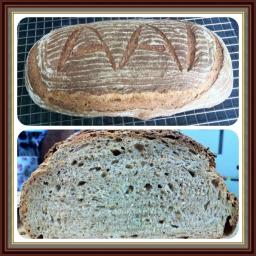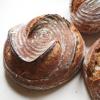This is my first TFL write up.
While I have only made some comments on posts within the last couple of months, I have been stalking the wonderful forums and submissions on this site since I started baking bread regularly, about four years ago. I think a big thank you to the collective of the website is in order, if not something more.
This particular bread was born out of frustration: I tried a 100% whole wheat miche about a week ago (all whole wheat, except for a rye starter) and it failed pretty miserably. I know why it failed. My apartment is cold (around 62 F), especially since it is a NYC basement apartment, and I wanted things to go much more quickly than they needed to. So, the loaf was under proofed and also, as I found out when I cut into it the next day, under baked. Out of shame, there are no pictures.
So, the next day I tried to redeem myself but ended up repeating many of the same mistakes. I again tried to rush things and was again disappointed. For this loaf, however, I made two modifications: 15g of toasted wheat germ in the final dough, and instead of going for 100% whole wheat (again, aside from the rye starter) I added 100g white bread flour. This made the final dough a little more forgiving, and this loaf I was willing to eat. However, with the high hydration of the dough (around 82%) and an under-floured banneton, the dough stuck when I unmolded it and this shows on the final loaf. So again, no photos.
The following was my attempt to redeem myself. I had just gotten back from a research trip in France and since I could still taste the bread the sting of frustration was all the more harsh.
Total Dough
200 g whole wheat flour (Bob’s Red Mill)
100 g white bread flour (Pillsbury—it’s what I had on hand)
15 g toasted wheat germ (Bob’s Red Mill)
100g rye starter at 100% (using NYC tap water and Arrowhead Mills organic rye)
7 g kosher salt
265 g water
Hydration: 86.3%
Preferment
100 g rye starter
200 g whole wheat flour
15 g toasted wheat germ
215 g water
Preferment temp was 23C / 73F
Covered and left alone at room temp for 24 hours. This day the kitchen temp hovered around a whopping 15C / 59F.

The Rest
100 g white bread flour
50 g water
7 g kosher salt
After mixing in the remaining flour and water—water into preferment, then flour—I let it rest for 30 minutes. Before kneading. I’m a fan of slap and fold and did that for two minutes before adding in the salt. Then, I kneaded for another 8 minutes before forming a boule and putting in an oiled bowl. Dough temp: 16.6C / 61.5F
The bulk ferment lasted 5 hours with three-part folds at 1.5 and 3 hours.
After 5 hours, I turned the dough out and pre-shaped the dough for a boule and let the dough rest for 20 minutes. I then shaped the boule, plopped it into a banneton—well-floured this time, mind you—and parked it in the fridge for 16 hours.

The next day I took it out of the fridge and let it come to room temperature (again, around 15C) for two hours on top of the oven, which was heating breakfast and then preheating for the bake.
I baked the loaf in my preheated cast iron skillet at 500F with steam for the first 20 minutes and then at 450F with no steam for another 25 minutes. At the end of the bake the loaf’s internal temperature reached 214F. I then left the bread in the oven for 1 hour after I killed the gas.

Oven spring was good, though not as even as I would have liked: again, a part of the dough stuck in the banneton. This banneton is newer, so this tendency to stick might decrease with use. I also might just outfit it with a linen liner.

I wish I had baked the loaf at 500F for the whole time, since I like an aggressively scorched crust and this loaf had only gotten chestnut brown. I also might need to do a check on the accuracy of my oven temps…
--Scott

A nutty and surprisingly not very dense loaf made by using Peter Reinharts's mash for sorghum & pearl millet. Also made a soaker of sorghum & pearl millet flours. The final dough had the mash, soaker, stiff levain, whole wheat flour, bread flour, salt, agave nectar & instant yeast. Loved the result.





















